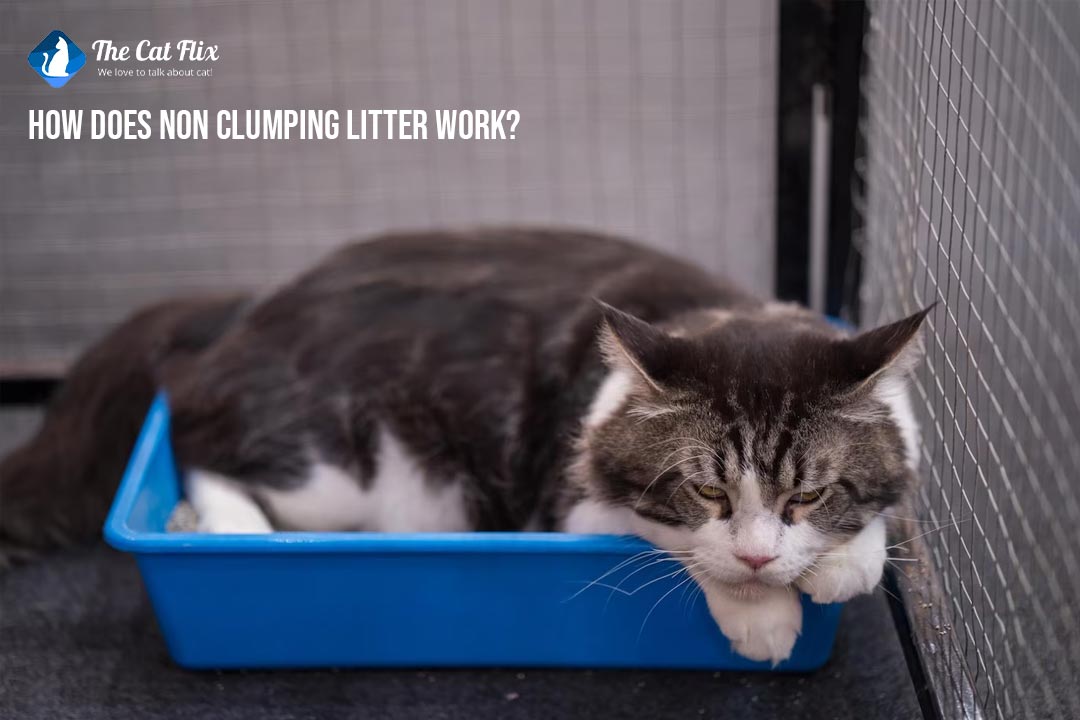Ah, the humble cat litter – that unsung hero of feline hygiene! That hero which keeps your home smelling fresh and your cat’s paws clean. It’s not just litter, it’s a scoop of convenience. But wait, have you ever wondered how does Non Clumping Litter Work?
Get ready for a wild ride through the fascinating world of cat hygiene. Where you will learn how non clumping litter works, its benefits, maintenance, and proper using and cleaning tricks.
What is Non-Clumping Litter?
Before we talk about what non clumping litter is, let’s see the types of litter. There are 2 types of litter. One is clumping litter, and another one is non-clumping litter, which is our today’s hero of the topic.
Non-clumping cat litter is the OG of the feline world. It’s been around long before those fancy clumping litters came into play. But what exactly is it?
Well, this litter is a type of absorbent material that’s mainly used for cat hygiene. Unlike clumping litter, which turns into solid clumps when it gets wet, non-clumping litter doesn’t form clumps.
Instead, it soaks up liquid while keeping the individual litter particles separate. So, non-clumping litter-simple, effective, and a bit old-school!
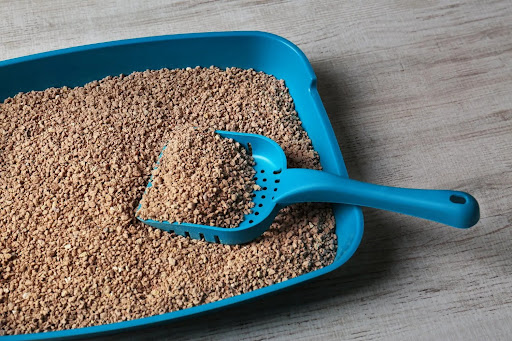
Materials/Ingredients of Non-Clumping Litter
Let’s breakdown of the materials and ingredients commonly used in non-clumping cat litter:
- Clay: Traditional non-clumping litters are made from clay. They are good at absorbing liquid and controlling smell.
However, as the litter becomes saturated, urine may pool at the bottom of the litter box, making it necessary to replace the entire box frequently.
- Crystal or Silica Gel: Some non-clumping litters use silica gel, or you can say crystal litter. These crystals are highly absorbent and can hold a significant amount of liquid.
They also help control odors effectively. Silica gel litters are often low-dust and have minimal tracking.
- Natural Alternatives: There are plant-based alternatives for non-clumping litter, including materials like pine, corn, wheat, beet pulp, wood. All of these give a natural fragrance, and are good for the environment.
Talking about litters, do you know cats can recognize their siblings from a different litter? If you don’t, read this article “Do Cats Know Their Siblings from Different Litters” and find out this interesting fact about our feline.
How Non Clumping Litter Works?
This non-clumping litter soaks a large amount of fluids and keeps odors at bay. That means if you remove any feces every day, the litter tray will stay fresh for up to a week. On the other hand, less high quality litter needs to be changed every few days.
Here I discussed how this litter works-
Composition Process
Non-clumping litter mainly consists of calcium bentonite clay. This clay absorbs both odors and urine without forming clumps. It’s like a sponge that soaks up liquid until it reaches its saturation point.
Once the threshold is reached, it’s time to change the litter and replace it inside your cat’s litter box.
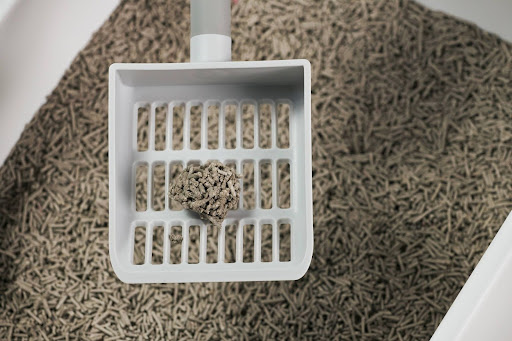
Absorption of Moisture
When your cat urinates or defecates in non-clumping litter, the granules absorb the liquid. These granules swell up and become softer, but they do not form clumps.
As the urine gets absorbed by the non-clumping cat litter granules, feces remain intact. Just like, No clumps to scoop – just a gradual saturation process.
Odor Control
A bonus for you (and the rest of your household): Non-clumping litter tends to be more absorbent of smells.
These litters are known for their absorbance ability and natural fragrance. It helps prevent strong smells. Some non-clumping litters even contain additives like baking soda or charcoal to further contain unpleasant odors.
Perfect for when your kitten is still figuring out how their body – and the litter box – works.
Drying of Feces
Since non-clumping litter doesn’t create clumps, feces remain separate from the rest of the litter. It’s like a neat separation of duties – one for liquid, one for solids.
Regular scooping is necessary to remove soiled areas and maintain a clean litter box.
Sometimes, many of us encounter constipation issues with our kittens. I personally experienced this when I adopted a kitten a few months ago. He was suffering from constipation, so I tried various home remedies to help him.
I believe there are quite few owners like me experienced this. So for them and for my dear readers, I’ve detailed all these strategies and preventive measures in an article, so go ahead and learn more.
Click here⇾ how to make a constipated kitten poop
Why Should You Choose Non Clumping Litter For Your Cat
When it comes to choosing cat litter, non-clumping options offer several advantages. How ? Here are some key advantages why you might consider non-clumping litter for your feline friend-
Key Advantages of Non Clumping Litter
1. Anti-Allergic Litter
Non-clumping litter is often less dusty, making it a better choice for cats with asthma or respiratory sensitivities. It minimizes airborne particles and reduces the risk of triggering allergies.
2. Cost-Effective
Non-clumping litter is generally more affordable than clumping varieties. If you’re looking for a budget-friendly option, non-clumping litter fits the bill.
3. Less Maintenance
Unlike clumping litter, which forms solid clumps when wet, non-clumping litter doesn’t require frequent scooping. You can simply remove soiled areas without disturbing the rest of the litter.
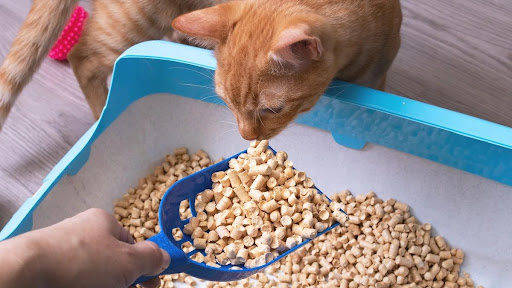
4. Low Dust Levels
Non-clumping litters tend to be less dusty, which benefits both your cat’s respiratory health and your home environment.
Watch this video⇾ Tidy Cats Non-Clumping Litter
5. Eco-Friendly
Many non-clumping litters are made from natural materials like clay, pine, corn, or recycled paper. They are biodegradable and some of them are clump-free. Choosing eco-friendly options helps reduce your environmental footprint.
Here, let’s see how a cat owner shares her firsthand experience and provides a review after using non-clumping litter.
Tidy Cats 24-7 Performance Non-Clumping Clay Review
6. Suitable for Multiple Cats
Non-clumping litter can be a practical choice if you have multiple cats sharing the same litter box. It provides ample absorbency without forming clumps that might be challenging to manage.
But some cat parents don’t like this concept. Often they wonder how to prevent this sharing-litter thing. Don’t worry, my friends. For your concern, this article is for you – how to stop cats from using other cats’ litter boxes.
How Often Should You Change Non-Clumping Cat Litter?
So, how frequently should you change the non clumping litter? Well, here is a small guide for you-
Here’s a guide on how often to change non-clumping cat litter:
- Scoop Solid Waste Daily: Every cleaning solid waste from the litter tray reduces odor. As a result, this extends the time between complete litter changes, and prevents cats from avoiding a soiled box.
- Frequency Based on Litter Type: If we compare between two, clumping needs monthly changes, or 2 -3 weeks for having more than one cat.
But for non-clumping cat litter, they may need changing 3 to 4 times a month. Or, twice a week. With daily cleaning, you could extend it to once every seven days.
- Consider Litter Material:
- Corn-Based Litter: May last up to 30 days.
- Wood Pellets: Typically need changing in half that time.
How Do You Keep Non-Clumping Litter Clean?
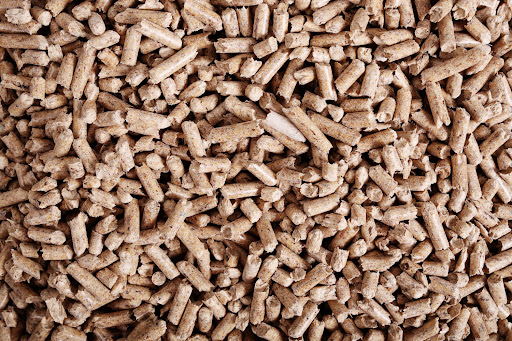
For cleaning purposes and maintaining hygiene, regular scooping is better. It keeps the litter box tidy and encourages your cat to use it.
Your daily mission – scoop out the solid waste (yes, cat poop) and dispose of it.
Furthermore, monitor urine absorption. Non-clumping litter absorbs urine naturally without forming clumps. So, if you notice urine pooling at the bottom of the litter box, it’s time for a change.
Tips for Using Non-Clumping Litter
- Weekly Litter Replacement:
- To clean non-clumping litter, dump the entire contents of the litter box into the trash.
- Wash the litter box with soap and water, then dry it thoroughly.
- Add 2 to 3 inches of fresh non-clumping litter and let your cat use it.
- Multiple Litter Boxes:
- Cats prefer a clean litter box. Having multiple litter boxes ensures your cat always has a fresh spot.
- Consider using different non-clumping litters in separate boxes to find the material your cat prefers.
- Test Different Litters: Use two litter boxes, each filled with a different non-clumping litter, to discover the material your cat likes best.
FAQs
Is non-clumping litter safe for cats, especially kittens?
Yes. Non-clumping litter is generally safe for cats, including kittens. It doesn’t form clumps, reducing the risk of blockages or ingestion.
Why do shelters use non clumping litter?
Shelters often choose non-clumping litter due to safety concerns. For instance, kittens can ingest clumping litter, which may cause issues. Therefore, non-clumping litter is safer and easier to manage in a shelter environment.
What happens if you mix clumping and non clumping litter?
Well, It is not recommended to mix clumping and non-clumping litter. Because mixing them may affect the scoopability of clumping litter. And consistency is essential for cats’ litter preferences.
Is it OK to flush non-clumping litter?
No, it is not safe to flush any type of cat litter down the toilet, including non-clumping litter. Because flushing cat litter can clog pipes, damage plumbing systems, and harm the environment.
Apart from that, cat poop may contain parasites like Toxoplasma Gondii, which can be dangerous to human health and contaminate water systems.
How do I get my cat to pee in a non-absorbent litter?
- When collecting a urine sample, use a non-absorbent cat litter designed for this purpose.
- Empty, clean, and dry your cat’s litter tray.
- Sprinkle the non-absorbent litter into the tray.
- Monitor your cat closely and collect the urine sample when needed.
- Alternatively, you can use safflower seeds or other non-absorbent materials.
Enclosure
Non-clumping litter is a reliable and cost-effective solution for maintaining your cat’s hygiene. It works by absorbing moisture and controlling odors without forming clumps.
By understanding the unique characteristics of non-clumping litter, you can make an informed choice to create a comfortable environment for your beloved pet.

